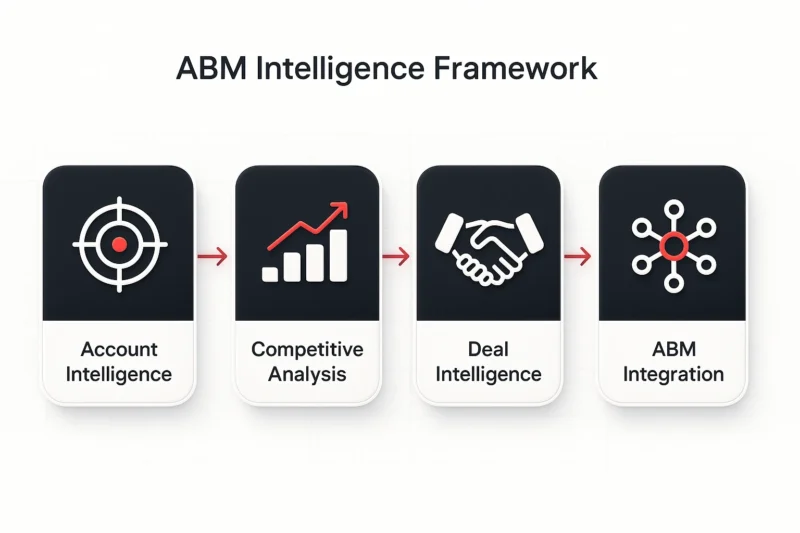How ABM Competitive Intelligence Drives Deal Success
The enterprise deal you’ve been nurturing for six months just went dark. Your champion stopped responding, meetings got postponed indefinitely, and you’re left wondering what competitor swooped in with the perfect message at exactly the right moment. This scenario plays out daily across B2B sales floors, but it doesn’t have to be inevitable.
The most successful Account-Based Marketing programs don’t rely on gut instinct or generic messaging. They’re powered by four interconnected intelligence systems that transform how teams identify, engage, and close high-value accounts. When ABM competitive intelligence, account intelligence, competitive analysis, and deal intelligence work in harmony, they create an unfair advantage that competitors simply cannot match.
Key Takeaways
- Integrate four intelligence pillars for maximum ABM impact – ABM competitive intelligence, account intelligence, competitive analysis, and deal intelligence must work together as an interconnected system rather than isolated tools to create an unfair competitive advantage
- Intelligence-driven ABM delivers measurable ROI improvements – Organizations using professional account-mapping and research services report 81% higher ROI than traditional lead-generation tactics, with win rates improving 15-30% against targeted competitors
- Real-time competitive signals prevent deal losses – Embedding competitive intelligence directly into CRM workflows allows sales teams to neutralize objections before they become deal blockers, resulting in 30% win rate improvements and faster deal closure
- Focus on actionable insights over data volume – Successful programs prioritize deep, actionable intelligence on fewer high-value accounts rather than collecting superficial data across many targets, with clear workflows for translating findings into specific campaign and sales actions
- Technology integration eliminates intelligence silos – The most effective implementations use unified dashboards that surface insights from multiple sources, enabling sales and marketing teams to make informed decisions quickly without switching between disconnected tools
TABLE OF CONTENTS:
Understanding the Four Pillars of ABM Intelligence
Before diving into implementation strategies, it’s crucial to understand how these four intelligence disciplines complement each other within your ABM ecosystem. Each serves a distinct purpose while feeding into a unified strategy that accelerates deal velocity and improves win rates.
Account Intelligence forms the foundation by providing deep insights into target organizations. Their structure, priorities, technology stack, key stakeholders, recent changes, and strategic initiatives. This intelligence informs everything from initial outreach timing to stakeholder mapping and conversation prioritization.
Competitive Intelligence reveals the broader market context by tracking competitors’ strategies, messaging, pricing changes, and customer movements. It enables teams to anticipate competitive threats, position offerings more effectively, and address buyer concerns before they become objections.
Deal Intelligence focuses on opportunity-specific insights that help win individual deals. This includes buyer intent signals, stakeholder influence patterns, pain points, timeline pressures, and budget considerations that directly impact deal outcome and velocity.
ABM Competitive Intelligence brings these elements together within account-based strategies, creating personalized competitive positioning that resonates with each target account’s specific context and concerns.
The Business Case for Intelligence-Driven ABM
The numbers speak volumes about the transformative impact of intelligence-driven ABM strategies. According to recent research from Forrester, organizations that integrate professional account-mapping and research services into their ABM programs report an 81% higher ROI than those relying on traditional lead-generation tactics.
This dramatic performance lift isn’t coincidental. When teams have access to comprehensive account intelligence, they can craft messages that address specific organizational challenges rather than generic industry pain points. The result is higher engagement rates, shorter sales cycles, and more predictable revenue outcomes.
“Real-time competitive signals embedded in ABM workflows directly translate into higher win rates. When sales teams know exactly how competitors are positioning against specific accounts, they can neutralize objections before they become deal blockers.” – Kompyte Case Study Analysis
The technology landscape is rapidly evolving to support this intelligence-driven approach. Competitive-intelligence teams recorded a 76% year-over-year increase in AI adoption, with 60% now using AI daily for data analysis, deal intelligence, and market monitoring. This technological acceleration is making sophisticated intelligence capabilities accessible to organizations of all sizes.
The broader market context reinforces this trend. The global account-based marketing market reached $1.41 billion in 2024 and is projected to grow at a 17.9% CAGR through 2030, driven largely by demand for more sophisticated targeting and personalization capabilities.
Building Your ABM Intelligence Framework
Creating an effective ABM intelligence system requires a structured approach that balances comprehensive data collection with actionable insights. The most successful implementations follow a systematic framework that ensures all four intelligence pillars work together seamlessly.

Phase 1: Account Intelligence Foundation
Begin by establishing comprehensive profiles for each target account. This involves gathering organizational intelligence (leadership structure, recent initiatives, company priorities), business intelligence (financial performance, market position, growth challenges), and technology intelligence (current stack, vendor relationships, integration requirements). The goal is creating a 360-degree view that informs every subsequent interaction.
Phase 2: Competitive Context Mapping
Layer competitive intelligence onto your account profiles by researching each target’s current vendor relationships, satisfaction levels, contract renewal timelines, and past evaluation criteria. Understanding which competitors are already engaged with your targets enables more strategic positioning and messaging.
Phase 3: Deal-Specific Intelligence
As opportunities progress, gather deal intelligence that provides tactical advantages. This includes stakeholder influence mapping, budget allocation insights, decision-making timelines, and competitive evaluation processes specific to each opportunity.
Phase 4: Integrated ABM Execution
Combine all intelligence streams into coordinated ABM campaigns that deliver the right message to the right stakeholder at the optimal moment. This integration phase is where theoretical intelligence transforms into measurable revenue impact.
Technology and Tools That Make It Work
Modern ABM intelligence requires sophisticated technology infrastructure that can collect, analyze, and activate insights across multiple touchpoints. The most effective implementations leverage integrated platforms that eliminate data silos and enable real-time decision making.
Customer Relationship Management systems serve as the central nervous system, but they must be augmented with specialized intelligence tools. Account intelligence platforms automate the collection of organizational data, while competitive intelligence tools monitor market movements and competitor activities in real-time.
The key is ensuring these tools work together rather than creating additional data silos. Leading organizations implement unified dashboards that surface actionable insights from multiple sources, enabling sales and marketing teams to make informed decisions quickly.
| Intelligence Type | Key Data Sources | Primary Use Cases | Success Metrics |
|---|---|---|---|
| Account Intelligence | CRM, Intent data, Technographics | Account prioritization, Stakeholder mapping | Account engagement lift, Meeting booking rates |
| Competitive Intelligence | Win/loss data, Market research, Social monitoring | Competitive positioning, Battle card creation | Win rate improvement, Competitive win percentage |
| Deal Intelligence | Call recordings, Email interactions, Proposal analytics | Deal coaching, Risk assessment | Deal velocity, Close rate optimization |
| ABM Integration | Multi-channel engagement data, Attribution modeling | Campaign optimization, ROI measurement | Pipeline acceleration, Revenue attribution |
Real-World Success Stories
The theoretical benefits of ABM intelligence become concrete when examining real-world implementations. Consider how Kompyte deployed competitive-intelligence platforms to track rivals’ messaging, pricing, and sales tactics, surfacing real-time alerts in their CRM so representatives could tailor outreach and marketing could trigger account-specific content. The result was a 30% improvement in win rate on target accounts and faster deal closure as objections were neutralized before becoming blockers.
Similarly, an enterprise B2B SaaS vendor partnered with an ABM agency to layer account-level intelligence with competitive insights, orchestrating targeted campaigns timed to contract cycles. Deal velocity improved 20% within two quarters and 40% by year-end, alongside steadier win rates across the enterprise segment.
These success stories share common elements: comprehensive data collection, real-time intelligence activation, and tight alignment between sales and marketing teams. The organizations that achieve the best results treat intelligence as a strategic capability rather than a tactical tool.
Common Pitfalls and How to Avoid Them
Even well-intentioned ABM intelligence initiatives can fail if they fall into predictable traps. The most common mistake is treating intelligence as a one-time research project rather than an ongoing strategic capability. Market conditions change, competitor strategies evolve, and account priorities shift. Your intelligence systems must adapt accordingly.
Another frequent pitfall is data collection without actionable insights. Teams often become so focused on gathering information that they forget to translate findings into specific actions. The most effective implementations establish clear workflows for turning intelligence into campaign adjustments, sales coaching, and strategic pivots.
Organizational silos present another significant challenge. When account intelligence lives in marketing, competitive intelligence sits with sales, and deal intelligence remains in CRM systems, teams lose the integrated view that drives superior results. Breaking down these barriers requires both technological integration and cultural change.
Finally, many organizations underestimate the importance of intelligence quality over quantity. It’s better to have deep, actionable insights on fewer accounts than superficial data on many targets. Successful ABM programs prioritize account selection and focus their intelligence efforts accordingly. Get a Free ABM Audit.
Measuring Intelligence Impact
The value of ABM intelligence ultimately comes down to measurable business outcomes. Leading organizations track both leading indicators (engagement rates, meeting conversion, pipeline velocity) and lagging indicators (win rates, deal size, customer lifetime value) to understand intelligence ROI.
Sophisticated analytics platforms enable multi-touch attribution that connects intelligence activities to revenue outcomes. This measurement capability is essential for justifying intelligence investments and optimizing resource allocation.
The most meaningful metrics often relate to competitive performance. Organizations with mature intelligence capabilities typically see win rate improvements of 15-30% against targeted competitors, along with shorter sales cycles and higher deal values.
Your Path to Intelligence-Driven ABM Success
Implementing comprehensive ABM intelligence doesn’t happen overnight, but organizations can begin realizing benefits immediately by focusing on high-impact activities. Start with your most strategic accounts and highest-value opportunities, then expand your intelligence capabilities as you demonstrate results.
The key is taking a systematic approach that balances quick wins with long-term capability building. Begin by auditing your current intelligence sources and identifying gaps that impact deal outcomes. Then prioritize investments in tools and processes that address your most critical blind spots.
Remember that ABM intelligence is ultimately about creating sustainable competitive advantages through superior market knowledge and account insights. Organizations that invest in these capabilities today will be positioned to capture disproportionate market share as competitive intensity increases.
The question isn’t whether your organization needs ABM intelligence. It’s whether you’ll build these capabilities before your competitors do. In an increasingly crowded B2B landscape, the organizations with the best intelligence will consistently win the most valuable deals.
Tired of watching competitors steal your best deals while you’re flying blind?
The post How ABM Competitive Intelligence Drives Deal Success appeared first on Single Grain.


